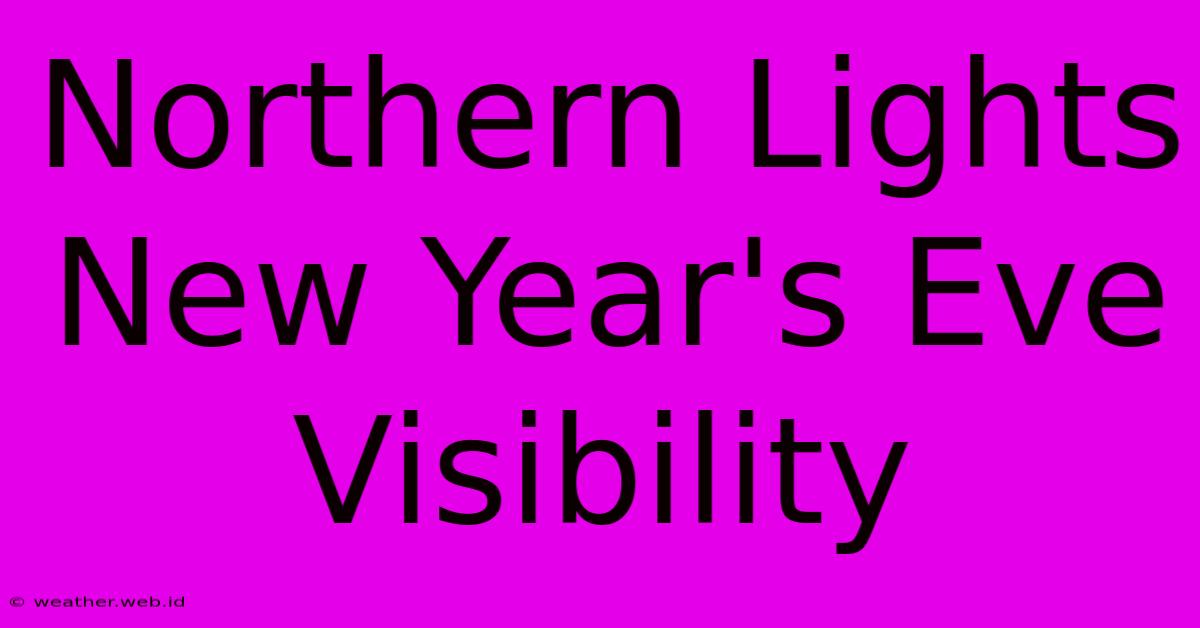Northern Lights New Year's Eve Visibility

Discover more detailed and exciting information on our website. Click the link below to start your adventure: Visit Best Website weather.web.id. Don't miss out!
Table of Contents
Northern Lights New Year's Eve Visibility: Your Guide to a Magical Celebration
Chasing the aurora borealis is a dream for many, and what better time to witness this celestial spectacle than on New Year's Eve? The magic of the Northern Lights combined with the celebratory atmosphere of the new year makes for an unforgettable experience. However, seeing the aurora is dependent on several factors, and planning ahead is crucial for maximizing your chances. This guide will help you understand the key elements influencing Northern Lights visibility on New Year's Eve and how to increase your odds of a breathtaking display.
Understanding the Factors Affecting Aurora Visibility
Several factors influence whether or not you'll see the Northern Lights on New Year's Eve, or any night for that matter. Let's break them down:
1. Solar Activity:
The Northern Lights are created by solar flares and coronal mass ejections from the sun. These events send charged particles towards Earth, interacting with our atmosphere to create the mesmerizing light displays. Stronger solar activity generally means brighter and more visible auroras. You can monitor space weather forecasts leading up to your trip to gauge solar activity levels. Websites and apps dedicated to aurora forecasting provide real-time updates on the KP index (a measure of geomagnetic activity). A higher KP index indicates a greater chance of aurora visibility.
2. Geomagnetic Conditions:
Even with strong solar activity, geomagnetic conditions can impact visibility. Geomagnetic storms can enhance aurora displays, pushing them further south than usual. Conversely, quiet geomagnetic conditions might result in fainter or less visible auroras, even with high solar activity.
3. Light Pollution:
This is a critical factor often overlooked. Light pollution from cities and towns drastically reduces your chances of seeing the Northern Lights. To maximize your viewing experience, you need to escape urban areas and find a location with minimal light pollution. Dark sky reserves and remote locations are ideal for aurora viewing.
4. Weather Conditions:
Clear skies are absolutely essential. Cloudy skies will completely obscure the aurora, regardless of solar activity or geomagnetic conditions. Check weather forecasts meticulously in the days leading up to your trip, prioritizing locations with a high probability of clear skies on New Year's Eve.
5. Time of Year:
While the aurora can be visible year-round, the long, dark nights of winter (typically November to February) provide the best viewing opportunities. New Year's Eve falls perfectly within this window, enhancing your chances.
Maximizing Your Chances of Seeing the Northern Lights on New Year's Eve
Here's how to optimize your chances of witnessing this spectacular event:
1. Choose the Right Location:
Popular aurora viewing destinations include Iceland, Norway, Sweden, Finland, Alaska, Canada, and Greenland. Research specific locations within these countries known for minimal light pollution and high aurora activity.
2. Check the Aurora Forecasts:
Regularly check aurora forecasting websites and apps in the days and hours leading up to New Year's Eve. These tools will provide valuable insights into the KP index and predicted aurora activity.
3. Find a Dark Location:
Escape the city lights! Head to a remote location away from urban areas for the best viewing experience.
4. Dress Warmly:
Aurora viewing often involves long periods spent outdoors in freezing temperatures. Dress in layers with warm, waterproof clothing.
5. Be Patient:
The aurora is a natural phenomenon, and its appearance can be unpredictable. Be patient and enjoy the experience, even if the aurora is subtle. Sometimes, a faint glow is just as magical as a vibrant display.
Conclusion: A New Year's Eve to Remember
Witnessing the Northern Lights on New Year's Eve is an incredible experience. By understanding the factors influencing aurora visibility and planning your trip accordingly, you significantly increase your chances of a truly unforgettable celebration under the celestial dance of the aurora borealis. Happy hunting!

Thank you for visiting our website wich cover about Northern Lights New Year's Eve Visibility. We hope the information provided has been useful to you. Feel free to contact us if you have any questions or need further assistance. See you next time and dont miss to bookmark.
Featured Posts
-
South Carolina Illinois Aim For 10 Wins
Jan 01, 2025
-
Alabama Vs Michigan Relia Quest Bowl Live Blog
Jan 01, 2025
-
2025 Nhl Winter Classic Blackhawks Game
Jan 01, 2025
-
Louisville Washington Sun Bowl Game Score
Jan 01, 2025
-
Alabama Michigan Score Key Highlights Of The Game
Jan 01, 2025
